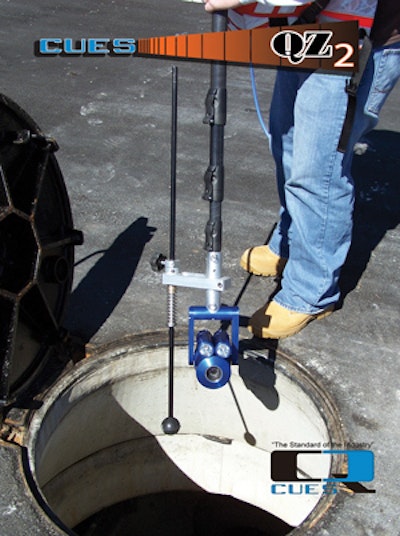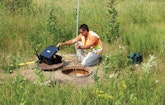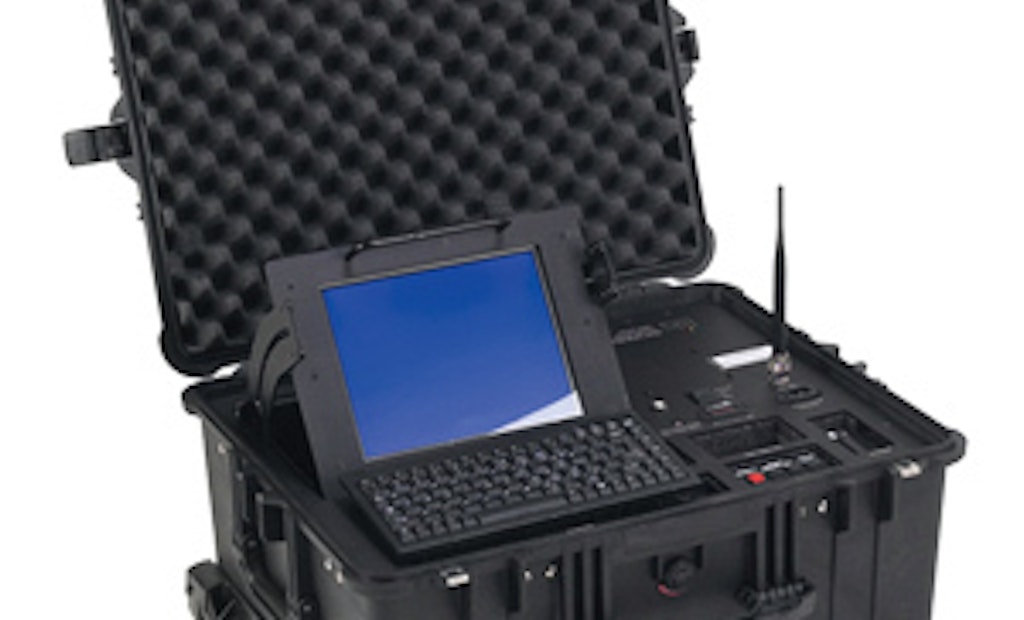Keeping people out of potentially dangerous environments is just one benefit of using pole cameras (also called zoom cameras) to inspect pipes and manholes. As digital camera technologies mature, pole cameras are providing better results than ever, with more zoom capability, better lighting, and even image stabilization.
While pole cameras cannot inspect entire pipes in the manner of crawler-mounted cameras, they do allow a good view of up to several hundred feet of a line to help crews determine how much crawler-based inspection is needed (if any) or to document that repair work has been completed satisfactorily.
Clear benefits
“A municipality can eliminate the need to run a camera in 25 percent of the lines,” says Dennis Parker, Florida sales manager at CUES. “That is a big savings.”
Richard Lindner, president of Envirosight, adds that crawler inspections can take significant time. “Zoom inspection with a pole camera gives you the power to understand the condition of every underground asset without spending a lot of time and money. You know exactly where to deploy crawler inspection, cleaning and rehabilitation resources.”
In addition, contractors can use the technology to help in bidding. “It allows them to better price and customize cleaning proposals to the actual pipe conditions, instead of just guessing, and that includes taking photos,” says Lindner. “That helps everyone make the best decisions.”
Parker says pole cameras have simplified something that was difficult only 10 years ago. “The ability to do a job like inspecting a manhole was not that easy,” he says. “Crews would hang their mainline camera on a rope to try to inspect a manhole. With pole cameras, it’s an easy task.”
Because of that, Parker expects the market to expand: “With the reduction of people in many sewer departments, the need to do more with less people is a top priority. Pole cameras allow one person to inspect both manholes and mainlines.”
Justin Femrite, product manager for Remote Vision System, sees another issue that he expects will drive expansion of the market. “The biggest change I think we’ll see is the continued limitations and safety issues with confined-space entry. As the industry becomes more aware of the safety hazards and OSHA requirements of confined space, they will continue to seek out other options to perform their inspections.”
Two kinds of zoom
Two key differences in cameras are the zoom capability and lighting. There are two kinds of zoom – optical and digital. Optical could be called true zooming, as it uses the lens to “get closer” to the item being inspected. Digital zooming (only on digital cameras) is the same as enlarging an image using editing software. Optical zooming maintains the image quality. In digital zooming, there is loss of quality as the image is enlarged.
Digital cameras have both kinds of zoom. Total zoom capability is often expressed as a single number that is the product of the optical zoom and digital zoom. For example, a camera with 35 times (35x) optical zoom and 12 times (12x) digital zoom has 420x total zoom capability. It is important to know how much of each type of zoom a given camera has. In general, more optical zoom is desirable, manufacturers say.
Zooming doesn’t help much if there isn’t enough light to illuminate the pipe. “New lighting technologies have greatly enhanced the range of zoom inspection cameras, allowing operators to capture more detail from farther away while maintaining perfectly aligned illumination,” adds Lindner. “These cameras have features that allow inspection of a wider range of infrastructure, like manholes and tanks.”
Varied applications
“Pole cameras are a great tool for engineering planning and troubleshooting problems within a collection system,” says Greg Fry, the national sales manager for Aries Industries. “They are a great first-look investigation and emergency troubleshooting device. Tractor-based systems are required to thoroughly inspect and inventory the condition of a collection system.”
Lindner agrees. “Crawlers give 100 percent inspection and can see beyond pipe bends, where zoom cameras can’t see,” he says. “Crawlers can also locate laterals, launch cameras into the lateral, digitally scan pipes, take measurements, and do other inspection tasks that are very valuable.”
Wireless technology has improved both the usability and functionality of pole cameras, according to fry. “A wireless system not only allows the video to be viewed locally at the inspection location, the video can be transmitted back to a remote recording device which allows a more detailed logging of inspection data.”
The length of the expandable poles varies. Most manufacturers offer a few options. Pole cameras have been found useful in many applications beyond sewer inspection, such as search and rescue, security, law enforcement and industrial maintenance. The U.S. military has used them in the Middle East, and photographers have been known to use them to get high-angle pictures without using a ladder or lift.
Here are descriptions of pole cameras of four (CUES, Envirosight, Aries, RVS) manufacturers who responded to an invitation from Cleaner to provide comments about the technology.
CUES
The QZ2 pole camera from CUES has image and video stabilization that eliminates shaking and blurring, especially when the camera is zooming out to long distances. “A person holding a pole camera is going to shake, and this feature eliminates that,” Parker says. “We spent many hours of video testing to compare the sharpness of the image with and without stabilization. It does no good to have a zoom feature of 35 times or greater without having a stabilized image.”
An ANSI Class 2 safety vest is part of the CUES pole camera system. “Having the LCD monitor on the vest instead of strapped to the pole reduces the weight of the pole camera,” says Parker.
The camera is mounted on a carbon fiber telescopic pole that extends to 24 feet; a 34-foot pole is optional. The camera zooms to 420 times (35x optical and 12x digital). It has two dual-wattage, high-intensity discharge (HID) lights of 9.5 and 14 watts. 800/327-7791; www.cuesinc.com.
Envirosight
The QuickView camera from Envirosight comes in two models: standard and Haloptic. The Haloptic package offers 20 times more illumination than conventional zoom systems for good images up to 400 feet, according to Lindner. “This new design dramatically boosts inspection range,” he says. “Because the illumination is axially aligned with the camera, an operator never needs to reposition. Optimum viewing is maintained automatically throughout the inspection.”
The camera has a zoom capability of 432x (36x optical, 12x digital) with image stabilization. Poles are available in extension lengths of 16, 24 and 30 feet. The operator vest holds the battery and control box. The portable digital viewer/recorder stores up to 12 hours of data that can be downloaded with a USB drive or MicroSD card. 866/936-8476; www.envirosight.com.
Aries Industries
The Aries HC3000 can serve as a portable, stand-alone inspection system or can be used with TV inspection monitors, a VCR, or a digital recording device. The high-resolution camera has a 432x zoom (36x optical, 12x digital) with detachable low-wattage, high-intensity LED lights. It is wireless and has an optional LCD portable monitor for daytime readability from up to 20 feet away. Controls and batteries are located on the pole rather than a vest or belt. 800/234-7205; www.ariesindustries.com.
Remote Vision System
The RVS pole camera product line includes two black-and-white systems and one with a color camera, the RVS Elite C. It includes LED lights, a daylight viewable color LCD monitor and DVR for recording and downloading video. 612/221-6690; www.remotevisionsystem.com.









